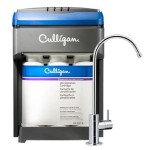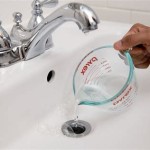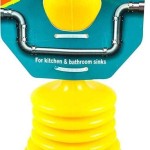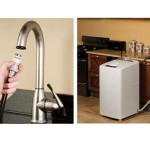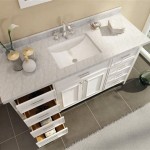Farmhouse Sinks for Laundry Room: Practicality and Charm
The laundry room, often relegated to a purely functional space, is increasingly becoming a focus for design and improvement. Within this evolving landscape, the farmhouse sink is emerging as a popular and practical addition. Farmhouse sinks, also known as apron-front sinks, traditionally associated with kitchens, are now finding a home in laundry rooms for their aesthetic appeal and functional benefits. These sinks offer a blend of rustic charm and modern utility, transforming the laundry room from a chore-driven area into a more inviting and efficient space.
The design elements of a farmhouse sink are distinctive. Characterized by its exposed front, or apron, the sink typically extends slightly beyond the surrounding cabinetry. This installation style allows for a more comfortable working position, as the user can stand closer to the sink without obstruction. Farmhouse sinks are typically deeper and wider than standard laundry sinks, providing ample space for handling large items, soaking clothes, and performing various laundry-related tasks. The materials used in their construction often include fireclay, stainless steel, cast iron, and composite materials, each offering different aesthetic and durability characteristics.
The implementation of a farmhouse sink in a laundry room introduces several practical advantages, improving the overall functionality of the space. Furthermore, the visual impact of a farmhouse sink can profoundly alter the atmosphere of the laundry room, contributing to a more pleasant and organized environment. The choice of material, size, and style should be carefully considered to ensure the sink meets the specific needs and complements the overall design of the laundry room.
Enhanced Functionality and Versatility
The primary advantage of a farmhouse sink in the laundry room lies in its enhanced functionality. The generous size and depth of these sinks make them ideal for a variety of tasks. Unlike smaller, shallower sinks, farmhouse sinks can easily accommodate large items such as bulky blankets, comforters, and oversized garments that require hand washing or soaking. The depth also helps prevent splashing, keeping the surrounding area cleaner and drier.
The versatility of a farmhouse sink extends beyond laundry-specific tasks. They can be used for a range of household chores, including washing pets, cleaning paintbrushes, or potting plants. The robust construction and durable materials of many farmhouse sinks make them suitable for handling heavy or messy items. This versatility can significantly increase the overall utility of the laundry room, transforming it into a multi-purpose space.
Consider the example of treating stained garments. The large basin of a farmhouse sink provides ample room to spread out the fabric and apply stain removers. This is particularly useful when dealing with large or awkwardly shaped items. Similarly, when hand washing delicate fabrics, the depth of the sink allows for gentle submersion and agitation without the risk of damaging the item. The convenience and accessibility offered by a farmhouse sink can make these tasks significantly easier and more efficient.
Furthermore, the ergonomic design of a farmhouse sink contributes to its functionality. The apron-front design allows the user to stand closer to the sink, reducing strain on the back and shoulders. This is particularly beneficial for individuals who spend a significant amount of time in the laundry room. The ease of access and comfortable working position can make laundry tasks less physically demanding.
Aesthetic Appeal and Design Integration
Beyond its practical benefits, a farmhouse sink significantly enhances the aesthetic appeal of the laundry room. The distinctive apron-front design adds a touch of rustic charm and character to the space, transforming it from a utilitarian area into a more inviting and visually appealing environment. The farmhouse sink can serve as a focal point, drawing the eye and creating a sense of warmth and homeliness.
The availability of farmhouse sinks in a variety of materials, colors, and styles allows for seamless integration into various design schemes. White fireclay sinks evoke a classic farmhouse aesthetic, while stainless steel options offer a more modern and industrial look. Composite materials provide a range of color choices, allowing homeowners to coordinate the sink with the existing laundry room decor. The versatility of these sinks makes them suitable for both traditional and contemporary homes.
Consider the impact of a white fireclay farmhouse sink in a laundry room with Shaker-style cabinetry and natural wood accents. The combination creates a cohesive and inviting space that feels both functional and stylish. Alternatively, a stainless steel farmhouse sink paired with sleek, minimalist cabinetry and concrete countertops can create a modern and industrial aesthetic. The choice of materials and finishes can significantly influence the overall look and feel of the laundry room.
The integration of a farmhouse sink into the laundry room design also extends to the surrounding fixtures and accessories. A stylish faucet, such as a gooseneck or bridge faucet, can complement the sink's aesthetic and enhance its functionality. Open shelving above the sink can provide storage for laundry supplies and decorative items, further contributing to the overall design. Thoughtful consideration of these details can transform the laundry room into a well-designed and visually appealing space.
Material Considerations and Durability
The choice of material for a farmhouse sink in the laundry room is a critical factor that affects its durability, maintenance, and aesthetic appeal. Common materials include fireclay, stainless steel, cast iron, and composite materials, each with its own set of advantages and disadvantages. Understanding the properties of each material is essential for making an informed decision that meets the specific needs and preferences of the homeowner.
Fireclay sinks are prized for their classic farmhouse aesthetic and exceptional durability. Fireclay is a ceramic material that is fired at extremely high temperatures, resulting in a dense and non-porous surface that is resistant to scratches, stains, and chips. Fireclay sinks are also relatively easy to clean and maintain, requiring only mild soap and water. However, they can be more expensive than other materials and may be prone to cracking if subjected to sudden temperature changes or impact from heavy objects.
Stainless steel sinks offer a modern and industrial aesthetic, as well as excellent durability and resistance to corrosion. Stainless steel is a non-porous material that is easy to clean and sanitize, making it a practical choice for a laundry room. Stainless steel sinks are also relatively lightweight and affordable. However, they can be susceptible to scratches and dents, and may show water spots and fingerprints more readily than other materials. The gauge of the stainless steel is an important consideration, with lower gauge numbers indicating thicker and more durable steel.
Cast iron sinks are known for their exceptional durability and heat retention. Cast iron sinks are coated with a layer of enamel, which provides a smooth and non-porous surface that is resistant to stains and scratches. Cast iron sinks are also effective at dampening sound, reducing noise from running water and dropped items. However, they are extremely heavy and require significant structural support. The enamel coating can also chip or crack if subjected to impact from heavy objects. Cast iron sinks can be more expensive than other materials.
Composite sinks are made from a blend of natural and synthetic materials, such as granite or quartz particles combined with resins. Composite sinks offer a range of color and texture options, as well as good durability and resistance to scratches and stains. They are also relatively lightweight and affordable. However, composite sinks may be more susceptible to heat damage than other materials and may require special cleaning products to maintain their appearance.
In summary, the selection of the appropriate material requires careful consideration of factors such as budget, aesthetic preferences, and anticipated use. Fireclay and cast iron sinks offer classic aesthetics and durability, while stainless steel provides a modern look and ease of maintenance. Composite sinks offer a range of color and texture options and a balance of durability and affordability.

Farmhouse Style For The Laundry Room Small Size Delivers Big With New Fiamma 23 Inch Fireclay Sink By Ruvati Usa

Top 5 Farmhouse Laundry Room Sinks Within The Grove

Ruvati 23 Inch Fireclay Farmhouse Kitchen Laundry Utility Sink Single Bowl White Rvl2468wh Usa

Homlylink High Back Farm Style Sink 24 In Wall Mount Single Bowl White Fireclay Farmhouse Kitchen Utility Laundry Em Fchb2db9a7w The Home

10 Laundry Room Sink Ideas That You Need To Try Out

5 Laundry Room Trends For 2024 Integra Builders

Diy Farmhouse Laundry Room Sink Cabinet Making Manzanita

70 Beautiful Farmhouse Laundry Room Ideas Nikki S Plate

Simple Project 24 In White Ceramic Farm Style High Back Wall Mounted Farmhouse Sink For Laundry Room Garage Kitchen Bathroom Hd Us Cls 1 The Home
:max_bytes(150000):strip_icc()/CarinaSkrobeckiPhoto_8311FrederickAve_29-0fc04a6ee4a24a75a5da402c21f7003e.jpg?strip=all)
57 Laundry Room Ideas That Ll Make Doing A Joy
